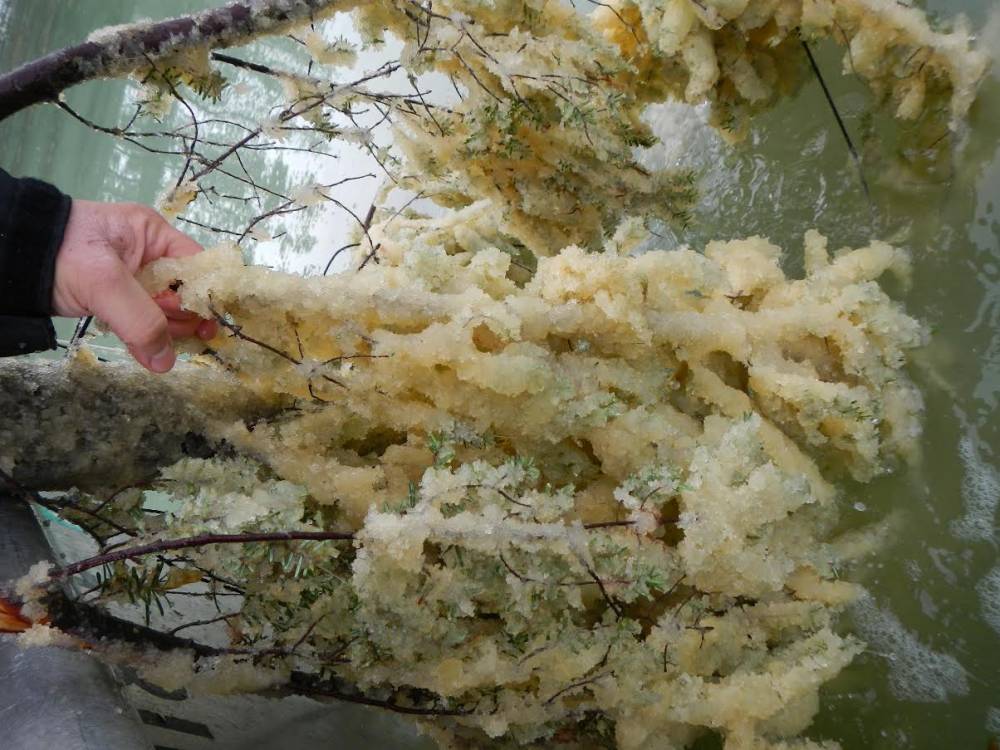
Hemlock branches covered in herring roe- Sitka Tribe of Alaska head of resource protection Jeff Feldpausch says that last year’s record low subsistence harvest was a deciding factor in STA’s decision to sue the Alaska Department of Fish and Game, demanding an injunction on the fishery (Photo/Sitka Tribe of Alaska)
The Sitka Tribe went into more detail today (Wednesday 12-18-18) about the lawsuit filed last week against the Alaska Department of Fish and Game and Board of Fish, calling for the state to intervene before the 2019 Sitka sac roe herring fishery. STA leadership spelled out their frustrations with state management, and offered some ideas for assuring the future success of both commercial and subsistence herring fishing in Sitka Sound.
After years of petitioning the Alaska Department of Fish and Game, calling for more a sustainable Sitka sac roe herring fishery, the Sitka Tribe of Alaska last week filed a lawsuit against ADF&G and the Alaska State Board of Fisheries. But why this year? And why not file an emergency petition through the Board of Fish? Sitka Tribe of Alaska chair KathyHope Erickson says that the tribe has been down that road before.
“We’ve been testifying before the board of fish for a couple of decades now at least, and it hasn’t gotten us very far,” Erickson said. “It’s getting to be such a dire situation.”
Jeff Feldpausch, head of resource protection, says that last year’s record low subsistence harvest combined with decisions made at the 2018 Board of Fish meeting in Sitka were the “straw that broke the camel’s back.”
“I would say over the last four or five years we’ve been putting out extra effort, extra sets, that kind of thing, and getting less back for that effort. Things weren’t getting better they were getting worse, and I think it just motivated the tribe to take it to the next level,” he said.
So they decided to pursue another avenue, and, represented by the Anchorage law firm Landye Bennet Blumstein, they’re calling for the state to intervene before the 2019 fishery begins, requiring ADF&G to develop a fishery management plan. If that happens, STA has an idea of what they’d what the plan to look like. STA General Manager Lisa Gassman says tribal representatives drafted a subsistence management plan earlier this fall with 5 key stipulations.
“Some of the things that the tribe indicated would need to be in that plan, were for the Department of Fish and Game to not open the commercial fishery until the minimum threshold was confirmed present with on the ground surveys and first spawn observed in Sitka Sound through aerial and deposition surveys,” she said.
They also want preseason meetings between the Tribe and state to discuss management concerns, as well as in-season consultations to discuss harvest rates and fishing conditions. If a test fishery is required, they want that to be a less-disruptive jig fishery rather than seining. And finally, they want the state to consider an emergency closure in the 2019 fishery if things aren’t looking good.
And Feldpausch says the Tribe wants to revisit the harvest limits they proposed at the 2018 Board of Fish meetings.
“I don’t know that we’re asking for it definitively in the plan, but I know at the last Board of Fish meeting we did ask for that reduction in the harvest rate from 12-20 percent sliding scale down to a 10 percent harvest rate like we do the rest of the stocks in Southeast.”
Gassman says Tribal representatives met with ADF&G in Juneau in October. They presented their subsistence plan.
“That wasn’t successful,” she said. “The department wasn’t willing to consider those, what we thought were important things moving forward for the 2019 fishery.”
Both Erickson and Feldpausch say that considering these practices in a fishery management plan wouldn’t just help the herring, the environment, or the subsistence harvesters. There’s a commercial incentive as well.
“I think it may even help the industry a bit. There’s been quite a glut of roe in the market. It’s kept prices depressed for several years,” he said. “Putting less roe on the market might drive those prices up. So the industry may make as much money as they have on a larger fishery with just harvesting less fish.”
“Personally, I’m totally for commercial fishery,” Erickson said. “My own grandpa was a commercial fisher for years and I just feel strongly that we’re in their ball court too, we’re doing this for them too,” she continued. “It’s a holistic thing. We’re not just using a microscope and looking in one direction. We’re doing this for everybody.”
As yet there is no official reply to the Tribe’s suit, which was filed in Sitka Superior Court on December 11. But state fishery managers have long suspected the dispute would end up in court. So far, they’ve stood by the forecast model that’s been used for over three decades. In previous reporting, area management biologist Eric Coonradt has said, “Unless we had a biological concern, we couldn’t close this fishery ourselves.”






























